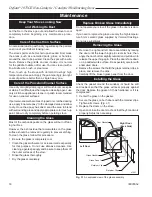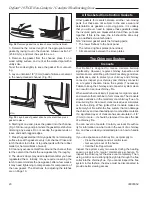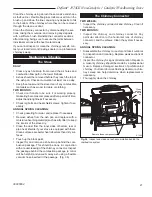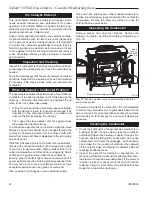
7
Defiant
®
1975CE Non-Catalytic / Catalytic Woodburning Stove
30005554
ST492
Defiant
freestanding
installation
11/00
Chimney
Elbow
Slip Pipe
Standard
Connector
Oval to
Round Adapter
Flue Collar
Thimble
Flue Liner
Flue
ST49
Fig. 5
Chimney connection in a freestanding masonry instal-
lation.
Securing the Single-wall connector to a
Masonry chimney
Both freestanding masonry chimneys and fireplace masonry
chimneys may be used for your installation.
Freestanding installations
If the chimney connector must pass through a combustible
wall to reach the chimney, follow the recommendations in
the Wall Pass-Through section that follows.
The opening through the chimney wall to the flue (the
“breech”) must be lined with either a ceramic or metal
cylinder, called the “thimble”, which is cemented securely
in place. Most chimney breeches incorporate thimbles, but
the fit must be snug and the joint between the thimble and
the chimney wall must be cemented firmly.
A special piece called the “thimble sleeve,” slightly smaller
in diameter than standard connectors and most thimbles,
will facilitate the removal of the chimney connector system
for inspection and cleaning. Thimble sleeves should be
available from your local dealer.
To install a thimble sleeve, slide it into the breech until it is
flush with the inner flue wall. Do not extend it into the actual
flue passage, as this could interfere with the draft.
The thimble sleeve should protrude 1-” (5-50mm) into
the room. (Fig. 6) Use furnace cement and thin gasket-
ing to seal the sleeve in place in the thimble. Secure the
chimney connector to the outer end of the sleeve with sheet
metal screws.
ST243
thinble connection
12/13/99 djt
Thimble Sleeve
Chimney Connector
Flue
Keep
sleeve
end flush
with flue
tile
ST43
Fig. 6
The thimble, made of either ceramic or metal, must be
cemented securely in place.
Without a thimble, a suitable length of chimney connector
can be extended through the breech to the inner face of
the flue liner, and cemented securely in place. Additional
pieces of connector are then attached with sheet metal
screws.
Fireplace installations
The chimney connector may be connected to the chimney
above the fireplace opening or through the fireplace.
above the Fireplace
The Defiant may be connected to a chimney above a
fireplace opening. (Fig. 7) In such installations, the stove
is positioned on the hearth in front of the fireplace and the
chimney connector rises from the stove top and then angles
ninety degrees back into the chimney. The chimney liner
should extend to the point at which the chimney connector
enters the chimney.
If the chimney connector from your installation enters the
chimney above a fireplace, follow all the guidelines men-
tioned above for freestanding installations. In addition, give
special consideration to the following points:
•
Check the clearance between the stove and the chimney
connector, and any combustible trim or the mantel. Use
the necessary combination of mantel, trim, and connec-
tor heat shields to achieve the required clearances.
•
Check the clearance between the chimney connector
and the ceiling. If no heat shields are used, the clear-
ance should be at least 610 mm (4”).
•
The fireplace damper must be sealed to prevent room
air from escaping up the flue. However, it must be
possible to re-open the damper to inspect or clean the
chimney.








































